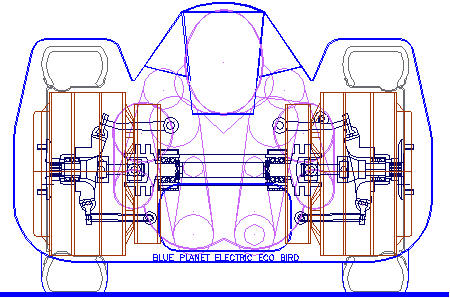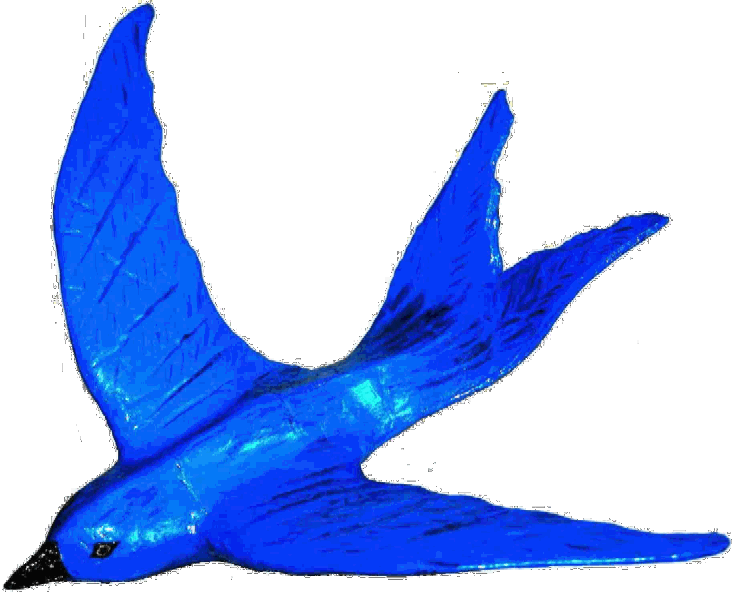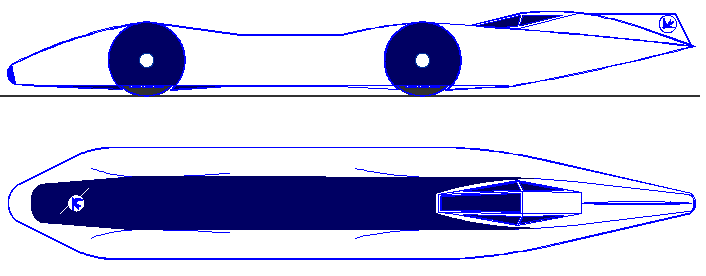|
|
|||||||||||||||||||||||||||||||||||||||||||||||||||||||||||||||||||||||||||||||||||||||||||||
|
HOME | INDEX | AUTOMOTIVE | BLUE PLANET BE3 | ELECTRIC CARS | ENERGY | FORMULA E | NEWS | SOLAR CARS |
|||||||||||||||||||||||||||||||||||||||||||||||||||||||||||||||||||||||||||||||||||||||||||||
|
Chain drive is often overlooked for its efficiency, when in fact it is an extremely effective method of transmitting drive with up to 95% of the power being transferred from one shaft to another. In addition to efficient transmission, chain drive is also flexible and adaptable, avoiding the need to cut special gears to change ratios, when off the shelf products can be matched to most tasks, simply be changing sprockets.
The drive chain of any vehicle is one of the most important components and yet normally gets the least attention. The standard drive chain of older motorcycles and cars are of the "Roller Chain" type. The chain consists of two major parts, 1) the pin link and 2) the roller link. |
|||||||||||||||||||||||||||||||||||||||||||||||||||||||||||||||||||||||||||||||||||||||||||||
|
Chain reference # |
Pitch |
Width |
|
415 |
1/2 inch |
3/16 inch |
|
420 |
1/2 inch |
1/4 inch |
|
428 |
1/2 inch |
5/16 |
|
520 |
5/8 inch |
1/4 inch |
|
525 |
5/8 inch |
5/16 inch |
|
530 |
5/8 inch |
3/8 inch |
|
630 |
3/4 inch |
3/8 inch |
-
O-Ring: similar to the standard but equipped with a rubber o-ring at each end of the pin. This o-ring traps in lubricant and keeps out road grit and moisture, thus prolonging the life of the chain.
-
Self-Lubricating: these chains incorporate oil-impregnated sintered metal bushings inside the rollers that gradually release oil to the chain.
Master link:  most
vehicle chains are connected into a loop by a master link. This is a
single pin link with
most
vehicle chains are connected into a loop by a master link. This is a
single pin link with
extended pins that allow the attachment of a removable side plate. The side plate is held in place by a spring clip.
Endless
Chain: some vehicles are equipped with an endless chain that does
not contain a master link but are connected back unto itself when
produced. These chains must be removed by removing the swingarm of the
bike.
Maintenance:
The more you care for your chain, the longer it will last. In this case where high pressures are applied for short duration, lubrication is important. After each run in adverse salt or dusty conditions the final drive should be cleaned and lubricated.
-
remove the chain from the vehicle and soak in kerosene (I know gasoline will also clean a chain but due to its fire potential, use kerosene).
-
if road grime and slight rust is a problem, scrub lightly with a hard bristle or metal brush.
-
hang the chain over the pan of kerosene and drip dry.
-
work your way down the chain testing the rollers and flexibility between each link. If you find links that will not flex freely even after forcing them, the chain needs replacing.
-
place the chain on the floor and measure out 1 foot. Grab the chain at each end of this foot length and push the chain links together. Now pull outward on the chain and note any change in its length. It is recommended that this movement be no more than 1/4 inch. Check the rest of the chain in 1 foot lengths. If the slack is more than 1/4 inch for any foot, the chain should be replaced.
-
relube the chain.
-
This is commonly done by using one of the aerosol can chain lubes available. CAUTION: if your chain is of o-ring design, make sure the chain lube is compatible.
-
A second way to lube your chain is by purchasing a can of solid lube. This material has to be heated, melting the solid, and the chain dipped in. The chain is hung over the can and allowed to drain and harden. This form of lube is longer lasting and will protect your chain the most.
-
reinstall your chain and set the slack to your manuals specs. If the chain adjuster on your rear axel indicates that the chain needs replacing, do so.
-
the master link spring clip open end MUST face away from the direction of rotation.
Sprockets
Whenever you check your chain, check your rear and drive sprockets also.
The teeth on both sprockets should be uniform and symmetric. If they
appear hooked or worn, they probably need replacing. Grant you, not
an easy thing to do between land speed record runs.
| Aprilia | Bimota | Cagiva | Ducati | Hasqvana | Honda | Husaberg |
| Kawasaki | KTM | Suzuki | Triumph | Yamaha | Harley Davidson & Others | |
www.didchain.com/question.html
| 1.Standard |
2.Strands |
3.Select
a chain |
4.Select
Centre Distances |
| Currently Selected Chain | Chain Description | Selection Data | |
| Enter Data Here | 110166 | ISO 606 32B-1 Bush Roller Chain | Selected For/Customer : |
| Input
Power KW Input Speed rpm Drive Teeth Z1 Driven Teeth Z2 Drive Load Driven Load |
Calculated
Data Chain Pitch 2.000 Ins 50.80 mm Ratio :1 Output Speed rpm Max Speed 380 rpm |
 Centre Distance
mm
Centre Distance
mmLinks |
Date
Created :08/22/2004 Selected By : Application : Email address: Summary Data Corrected Power: 10.00 KW Max power at this speed: KW Power Deviation: % Chain Velocity: m/s Bearing Pressure: N/mm˛ Safety Factor: :1 Approx Wear Life: hours Approx Fatigue Life: hours |
| Chain Statics | Chain Dynamics | ||
| Modified Centre Distance | mm | Chain linear velocity | m/s |
| No of chain links | Chain working load | N | |
| Chain Length | mm | Chain peak loads | N |
| Chain total mass | Kg | Chain Breaking load (min) | N |
| Pitch Circle Dia Z1 | mm | Safety factor (Peak loads) | :1 |
| Z2 | mm | ||
| Bearing area | mm˛ | Bearing Pressure | N/mm˛ |
| Chain selection power limit | KW | Power compared to max | % |
| Recommended lubrication | Speed compared to max | % |
Contacts:
Renold plc, Renold House, Styal Road,
Wythenshawe, Manchester, M22 5WL UK
Tel: +44 (0)161 498 4500 Fax: +44 (0)161 437
7782
E-Mail: enquiry@renold.com
Sponsors are invited to underwrite showing of the vehicle in 2014 & 2015 at a venue to be arranged. The car will be available for rolling displays early next year. Contact 'ACE' with your interest.

![]() The Blueplanet Ecostar is long and low. It features battery cartridge
refueling.
The Blueplanet Ecostar is long and low. It features battery cartridge
refueling. ![]()
The driver sits at the rear dragster fashion, the battery cartridge is in the front
all the way to the nose cone. Check out the battery cartridge exchange sequence below.
![]() Contact us:
Contact us:
or phone UK:
![]()
+44 (0) 1323 831727 +44 (0) 7842 607865
Bluebird Marine Systems Ltd
![]() Intelligent Battery Support System
Intelligent Battery Support System ![]()
THE BLUE BIRDS OF HAPPINESS
|
If your land speed record car cannot refuel itself like this, you are at a huge disadvantage. Blueplanet is around 66% the weight of a car that does not have cartridge exchange refueling for the same performance. complicated service station to refuel itself in under 2 minutes. |
EDUCATION | E. CYCLES | SOLAR CARS | SOLAR CAR TEAMS | SOLARNAVIGATOR
This
website is copyright © 1991- 2013 Electrick Publications. All rights
reserved. The bird logo ![]() and
names Blueplanet Ecostar and Bluebird
are trademarks ™. The Blueplanet BE3 vehicle configuration is
registered ®. All other trademarks hereby acknowledged.
and
names Blueplanet Ecostar and Bluebird
are trademarks ™. The Blueplanet BE3 vehicle configuration is
registered ®. All other trademarks hereby acknowledged.
Max Energy Limited is an educational charity working for world peace.










